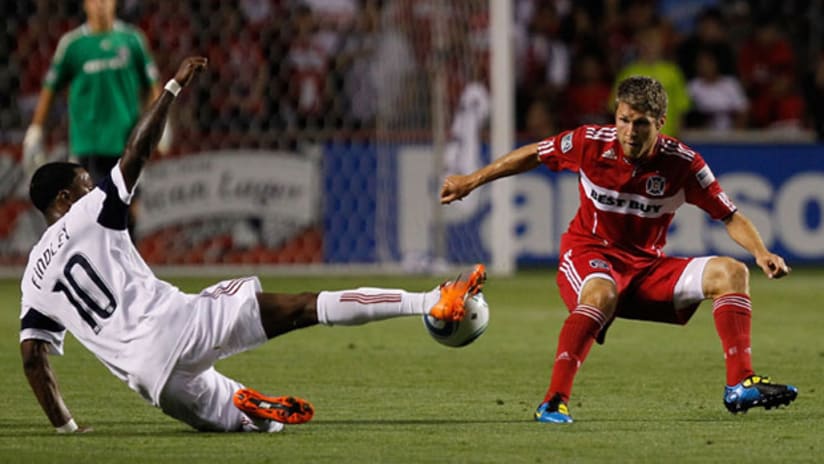Thursday’s interconference match-up on ESPN2 featured two teams heading in opposite directions. The result -- a 1-0 win for Real Salt Lake over Chicago -- kept that trend going, as RSL continued to thrive and the Fire once again struggled to find a definitive 90-minute effort.
WATCH: FULL MATCH HIGHLIGHTS
The Formations: Coach Jason Kreis put RSL out in their traditional 4-4-2, which is nominally a diamond with playmaker Javier Morales at the top and Ned Grabavoy (in place of injured captain Kyle Beckerman) at the base protecting the central defense.
The 4-4-2’s strength lies in its intuitiveness for most players. It’s not precisely easy to play, but the angles and spacing -- particularly for a team as well-drilled as RSL -- make sense. That leads to quicker play through the middle and devastating counterattacks.
Fire boss Carlos de los Cobos, on the other hand, went with an ultra-defensive 4-3-2-1, asking Stefan Dimitrov to do the heavy lifting up front. For a number of reasons, it didn’t work. Dimitrov barely saw the ball in his 45 minutes and the Fire didn’t create a single good scoring chance
De los Cobos also moved traditional defenders Wilman Conde and Mike Banner to the defensive midfield spot, and the team suffered. The three-man defensive midfield protected a static four-man back line, putting the entire creative onus on attackers Marco Pappa and Baggio Husidic. With the exception of the occasional 35-yard shot or cross from the right side, RSL were able to handle the pair easily.
The First 45: ESPN color analyst Kyle Martino did a great job pointing out the flexibility of RSL’s midfielders. On attack they constantly swapped roles, creating time and space in which to work while generating confusion in the Fire midfield. Defensively, because they’re so disciplined and familiar with Kreis’ system, one was always left in position to shield the back line.
But the biggest reason RSL dominated the first half was because the Fire were terrified of Robbie Findley’s speed. The Chicago back line was incredibly deep and dislocated from their midfielders, and the only explanation is that de los Cobos wanted to stifle any breakaways before they could happen. It came very close to being pure bunker-ball.
For the most part it worked. Findley and his strike partner Alvaro Saborio were quiet, save for a five-minute burst near the end of the half.
The Goal: RSL spent most of the first half unable to find any gaps in the Fire’s ultra-defensive set-up. But things changed quickly once Saborío settled himself between the Fire’s central defense and defensive midfield instead of playing directly off the shoulder of the central defenders. In rapid succession this small positional switch led to a shot on goal for midfielder Andy Williams (saved), a chance that Findley rattled the post with, and finally, the goal.
The build-up to the goal was simple: Findley found space between Pause and central defender C.J. Brown, then dribbled toward the box. Instead of making a hard diagonal run, Saborío drifted toward the back post -- taking Conde and central defender Kwame Watson-Siriboe with him -- isolating Findley on Brown while Pause tried to catch up. Pause couldn’t, Brown committed a touch foul in the box, and Findley flopped for the PK. He converted easily for the only score of the night.
The Second 45: De los Cobos undid his mistakes in tactics and team selection from the very beginning of the second half by bringing in Brian McBride for Dimitrov and Justin Mapp for Pause. The Fire switched to a 4-2-3-1, with McBride as the lone forward, Husidic just behind him, and Mapp as a left winger. Pappa was nominally on the right, but actually ran in a completely free role.
At the same time, de los Cobos brought the defense closer to the now two-man defensive midfield and gave right back Steve Kinney, seeing his first action in MLS, license to attack almost at will.
In the end it didn’t result in a goal, but it probably should have. Within the first 30 seconds of the half, McBride was able to control a Kinney cross, turn and push a shot just wide. Husidic followed that up minutes later by getting on the end of another Kinney cross, but scuffed his shot. On the ensuing corner, Kinney himself hit the post with a header. It was the first of two times he’d rattle the woodwork on the night.
RSL were forced to adjust in order to account for Kinney’s runs from the back, McBride’s ability to hold the ball and bring other attackers into the play, and Mapp’s speed and one-on-one ability. These factors ended up spreading out the RSL midfield, which limited their opportunities for quick combination play (short-short-long) and made them much more static on the attack.
In other words, by making overtly offensive substitutions and tactical changes, the Fire became more dynamic and solid defensively. They’d have been rewarded with at least a point if the soccer gods weren’t so cruel.
Final Thoughts: Chicago’s dominant second half won’t make Kreis abandon the 4-4-2, nor should it. But the manager will have some minor adjustments to make the next time his side faces a team that uses the 4-2-3-1.
On the other side of the ledger, the Fire will hope to build on their impressive second half performance and put the trial-and-error portion of the season behind them. After months of struggling to get the tactics and lineups straight, it certainly looked like de los Cobos found the system and personnel that work best.


